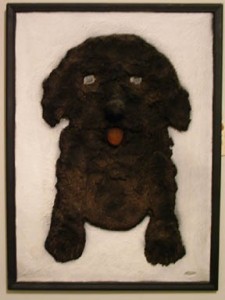 BYRON, ARCHIE
BYRON, ARCHIE
(1928–)
is one of the few vernacular artists ever elected to political office. He has also developed a medium—sawdust mixed with glue—that he uses in bas-reliefs andfreestanding sculptures to convey his thoughts about gender, ethnic, and personal identity. Byron has lived in Atlanta since his birth. His father was a music instructor.Raised primarily by his maternal grandmother (part Native American, part English, and also named Archie) in the Buttermilk Bottom neighborhood, Byron was achildhood playmate of Martin Luther King Jr.’s, and attended Catholic school. After serving in World War II and attending a vocational school for brick masonry andarchitectural drawing, Byron tried to join the Atlanta police force but failed to meet its minimum height requirement, so he became a mason instead. In 1961, however,he founded a detective agency.By the mid-1970s Byron owned several businesses, including a bait shop, gun-repair service, firing range, and security guard training school. In 1975, while workingas a security guard, he was intrigued by a tree root that he found at a construction site. Soon afterward, he was making root-based sculptures for his home. A fewyears later, he noticed piles of sawdust lying on the floor of the gun-repair workshop, and another idea possessed him. Sensing “a beauty there that shouldn’t bewasted,” he mixed sawdust with household glue to create a paste that he modeled into painted relief sculptures and three-dimensional wall hangings on wood supports.These were made at first for home use. Many of the earliest works, such as his eerie still life,
Black Roses,
and his street scenes of ghetto life, were inspired by home-decor paintings refracted through his interest in black consciousness.In 1981, unhappy with government services in his impoverished neighborhood, Byron ran for city council, won, and served for eight years. During his council termshis art moved away from overt political commentary and toward metaphysical issues. He began emphasizing biological commonalties of men and women (as in his four
Anatomy
works, which display a hydra-like male/female human radiating arms, legs, ears, and eyes) as well as the guiding roles of family and heredity. The moreinward-looking reliefs, dating from the mid-1980s, feature human forms less obviously African American and more generalized in appearance, as Byron searched for common denominators among both the sexes and the races. His works finally became less obviously painted, allowing the natural tawny colors of the claylike sawdustcompote to show proudly, and he achieved his original social goals by alternative means.
See also
African American Folk Art (Vernacular Art)
.
BIBLIOGRAPHY
Arnett, Paul, and William Arnett.
Souls Grown Deep: African American Vernacular Art of the South,
vol. 1. Atlanta, Ga., 2000
